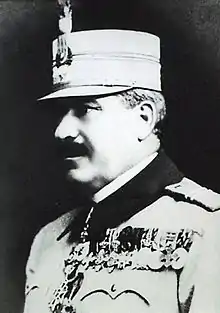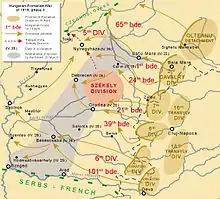Traian Moșoiu
Traian Moșoiu (July 2, 1868 – August 15, 1932) was a Romanian general during World War I and the Hungarian–Romanian War. He held the posts of Minister of War in the Alexandru Vaida-Voevod cabinet (December 1919 – March 1920), Minister of Communications and of Industry and Commerce in the Ion I. C. Brătianu cabinet (January 1922 – March 1926).
Traian Moșoiu | |
|---|---|
 General Traian Moșoiu | |
| Born | July 2, 1868 |
| Died | August 15, 1932 (aged 64) |
| Buried | |
| Allegiance | Romanian Army |
| Service/ | Infantry |
| Years of service | 1891–1932 |
| Rank | General |
| Battles/wars | Second Balkan War World War I–Romanian Campaign Hungarian–Romanian War |
| Awards | Order of Michael the Brave, 3rd Class |
| Minister of War | |
| In office March 2, 1920 – March 11, 1920 | |
| Prime Minister | Alexandru Vaida-Voevod |
| Preceded by | Ioan Rășcanu |
| Succeeded by | Ioan Rășcanu |
| Minister of Communications | |
| In office January 24, 1922 – October 29, 1923 | |
| Prime Minister | Ion I. C. Brătianu |
| Minister of Industry and Commerce | |
| In office October 30, 1923 – March 29, 1926 | |
| Prime Minister | Ion I. C. Brătianu |
| Alma mater | Ludovica Academy Theresian Military Academy |
Early life
Moșoiu was born in 1868 in the village Újtohán/Tohanul Nou, at the time in Austria-Hungary, now part of Zărnești, Brașov County. He went to the Andrei Șaguna High School in Brașov, then studied at the Ludovica Academy in Budapest and the Theresian Military Academy in Vienna. He graduated from the latter academy on June 1, 1889 with the rank of second lieutenant in the Austro-Hungarian Army, and was sent to the Sibiu garrison.
Career in the Romanian Army
In 1891, Moșoiu moved to Romania and joined the Romanian Army ranks. He commanded companies in the 9th Regiment Romanați (1901–1904) and the 9th Battalion Vânători in Ploiești, the 1st Infantry Battalion of the 30th Regiment Muscel, the 6th Regiment Mihai Viteazul in Bucharest, and the 7th Battalion Vânători in Galați.
He saw action in the military campaign in Bulgaria during the Second Balkan War and on October 1, 1913, he was appointed commander of the 30th Regiment Vânători at Câmpulung, holding the rank of Lieutenant-Colonel.
World War I
Romania was neutral for the first two years of World War I, entering on the side of the Allied powers on 27 August 1916. The start of the war found Moșoiu as commanding officer of 2nd Regiment Vâlcea and commander of the military group assigned to the Olt–Lotru sector, when he played a decisive role in the Nagyszeben Offensive. From 26–29 September his units fought tenaciously in the Olt Valley with the 1st Army Corps led by General David Praporgescu, blocking an attempted breakthrough of the 9th German Army under the command of Erich von Falkenhayn. During the Romanian Campaign of 1916 he commanded the 3rd Infantry Brigade and then the 23rd Infantry Division. In January 1917 he was promoted to brigadier general and put in command of the 12th Infantry Division. For his bravery during the Battle of Transylvania in the fall of 1916 he was awarded on 2 January 1918 the Order of Michael the Brave, 3rd Class.
On 3 March 1918, after the October Revolution, the Bolsheviks signed a separate peace with the Central Powers in the Treaty of Brest-Litovsk. Romania was alone on the Eastern Front, a situation that far surpassed its military capabilities; therefore, on 7 May 1918, Romania sued for peace. On 10 November 1918 Romania re-entered the war on the side of the Allies. King Ferdinand called for the mobilization of the Romanian army and ordered it to attack by crossing the Carpathian Mountains into Transylvania. The end of World War I that soon followed did not bring an end to fighting for the Romanian army; its mission continued into 1918 and 1919 in the Hungarian–Romanian War.
The Hungarian–Romanian War

_33.jpg.webp)

On 1 December 1918, the Union of Transylvania with Romania was officiated by the elected representatives of the Romanian people of Transylvania. Later that month, Romanian units reached the line of the Mureș River, which was the demarcation line agreed upon by the representatives of the Allied powers and Hungary. On 10 December, a unified command of the Romanian army in Transylvania was established; its headquarters were at Sibiu, with Moșoiu in command.[1] On 12 March 1919 he was appointed Military Governor of Transylvania.
On 21 March Béla Kun led a successful communist coup d'état in Hungary; he formed a social democratic, communist coalition government and proclaimed the Hungarian Soviet Republic. General Gheorghe Mărdărescu was in command of the Romanian army in Transylvania, with General Moșoiu in command of the Army Group North. By 18 April, the first elements of the Romanian offensive were completed and the Hungarian front was broken. Moșoiu's troops took control of western Transylvania, including the cities of Șimleu Silvaniei, Beiuș, and Oradea by 20 April, and then Salonta, Carei, and Satu Mare, pressing on to the Tisza River. The Hungarian forces retreated to Szolnok and from there across the Tisza, establishing two concentric defense lines. Between 29 April and 1 May, the Romanian Army broke through these lines, establishing control on the entire east bank of the Tisza. On 2 May, Hungary sued for peace, with Kun prepared to recognize all of Romania's territorial demands. General Moșoiu became the governor of the military district between the Romanian border and the Tisza River.
After repelling attacks by the Hungarian Army in July 1919, the Romanian Army crossed the Tisza River at the end of the month and advanced towards Budapest. On 2 August, Kun fled Hungary towards the Austrian border and eventually reached the Soviet Union. On 3–4 August some 400 Romanian soldiers with two artillery guns took hold of the city. Soon after, the bulk of the Romanian troops arrived in the Budapest and a parade was held through the city center in front of their commander, General Moșoiu. Romanian forces continued their advance into Hungary, stopping at Győr; they occupied all of Hungary with the exception of an area around Lake Balaton. Moșoiu was named commander of the Romanian military garrison in Budapest and Military Governor of the Hungarian territory to the west of the Tisza River.
After the War
In December 1919 he retired from the Army, joined the National Liberal Party, and was named Minister of War in the Alexandru Vaida-Voevod cabinet, serving in this position until March 1920.
Moșoiu died in Bucharest on 15 August 1932. He is buried at Bellu Cemetery, in Bucharest.
In 2007, on the 75th anniversary of his death, a bust of Moșoiu was erected in Bran, Brașov County; the inaugural ceremony was attended by then-President Traian Băsescu.[2]
References
- "Prezentarea Diviziei 4 Infanterie "Gemina"" (in Romanian). Retrieved May 18, 2020.
- Sandru, Alexandra (12 August 2007). "Bran: Traian Băsescu, prezent la dezvelirea statuii generalului Moșoiu". ziare.com (in Romanian). Retrieved May 18, 2020.
_13.jpg.webp)